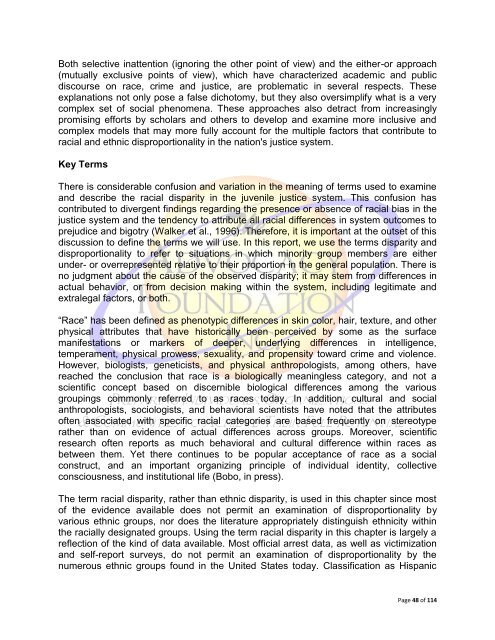African-American Youth in The Juvenile Justice System
African-American Youth in The Juvenile Justice System
African-American Youth in The Juvenile Justice System
Create successful ePaper yourself
Turn your PDF publications into a flip-book with our unique Google optimized e-Paper software.
Both selective <strong>in</strong>attention (ignor<strong>in</strong>g the other po<strong>in</strong>t of view) and the either-or approach<br />
(mutually exclusive po<strong>in</strong>ts of view), which have characterized academic and public<br />
discourse on race, crime and justice, are problematic <strong>in</strong> several respects. <strong>The</strong>se<br />
explanations not only pose a false dichotomy, but they also oversimplify what is a very<br />
complex set of social phenomena. <strong>The</strong>se approaches also detract from <strong>in</strong>creas<strong>in</strong>gly<br />
promis<strong>in</strong>g efforts by scholars and others to develop and exam<strong>in</strong>e more <strong>in</strong>clusive and<br />
complex models that may more fully account for the multiple factors that contribute to<br />
racial and ethnic disproportionality <strong>in</strong> the nation's justice system.<br />
Key Terms<br />
<strong>The</strong>re is considerable confusion and variation <strong>in</strong> the mean<strong>in</strong>g of terms used to exam<strong>in</strong>e<br />
and describe the racial disparity <strong>in</strong> the juvenile justice system. This confusion has<br />
contributed to divergent f<strong>in</strong>d<strong>in</strong>gs regard<strong>in</strong>g the presence or absence of racial bias <strong>in</strong> the<br />
justice system and the tendency to attribute all racial differences <strong>in</strong> system outcomes to<br />
prejudice and bigotry (Walker et al., 1996). <strong>The</strong>refore, it is important at the outset of this<br />
discussion to def<strong>in</strong>e the terms we will use. In this report, we use the terms disparity and<br />
disproportionality to refer to situations <strong>in</strong> which m<strong>in</strong>ority group members are either<br />
under- or overrepresented relative to their proportion <strong>in</strong> the general population. <strong>The</strong>re is<br />
no judgment about the cause of the observed disparity; it may stem from differences <strong>in</strong><br />
actual behavior, or from decision mak<strong>in</strong>g with<strong>in</strong> the system, <strong>in</strong>clud<strong>in</strong>g legitimate and<br />
extralegal factors, or both.<br />
“Race” has been def<strong>in</strong>ed as phenotypic differences <strong>in</strong> sk<strong>in</strong> color, hair, texture, and other<br />
physical attributes that have historically been perceived by some as the surface<br />
manifestations or markers of deeper, underly<strong>in</strong>g differences <strong>in</strong> <strong>in</strong>telligence,<br />
temperament, physical prowess, sexuality, and propensity toward crime and violence.<br />
However, biologists, geneticists, and physical anthropologists, among others, have<br />
reached the conclusion that race is a biologically mean<strong>in</strong>gless category, and not a<br />
scientific concept based on discernible biological differences among the various<br />
group<strong>in</strong>gs commonly referred to as races today. In addition, cultural and social<br />
anthropologists, sociologists, and behavioral scientists have noted that the attributes<br />
often associated with specific racial categories are based frequently on stereotype<br />
rather than on evidence of actual differences across groups. Moreover, scientific<br />
research often reports as much behavioral and cultural difference with<strong>in</strong> races as<br />
between them. Yet there cont<strong>in</strong>ues to be popular acceptance of race as a social<br />
construct, and an important organiz<strong>in</strong>g pr<strong>in</strong>ciple of <strong>in</strong>dividual identity, collective<br />
consciousness, and <strong>in</strong>stitutional life (Bobo, <strong>in</strong> press).<br />
<strong>The</strong> term racial disparity, rather than ethnic disparity, is used <strong>in</strong> this chapter s<strong>in</strong>ce most<br />
of the evidence available does not permit an exam<strong>in</strong>ation of disproportionality by<br />
various ethnic groups, nor does the literature appropriately dist<strong>in</strong>guish ethnicity with<strong>in</strong><br />
the racially designated groups. Us<strong>in</strong>g the term racial disparity <strong>in</strong> this chapter is largely a<br />
reflection of the k<strong>in</strong>d of data available. Most official arrest data, as well as victimization<br />
and self-report surveys, do not permit an exam<strong>in</strong>ation of disproportionality by the<br />
numerous ethnic groups found <strong>in</strong> the United States today. Classification as Hispanic<br />
Page 48 of 114

















